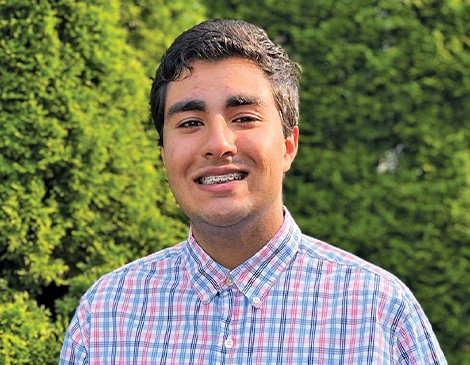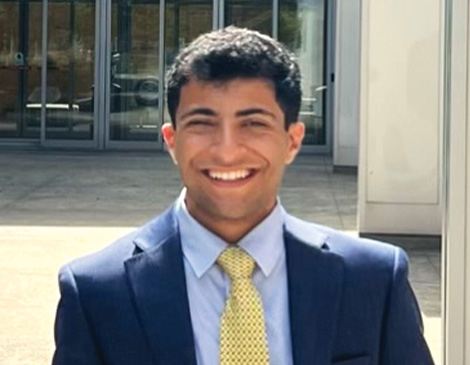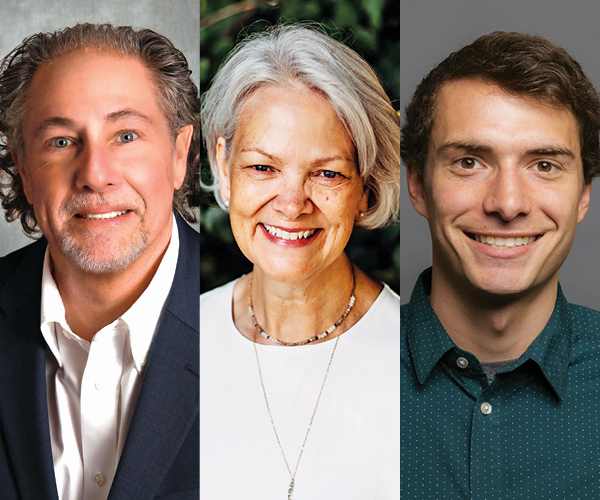Green High School students, grades 10-12, have a unique opportunity to gain exposure to the people and processes of local government, thanks to the Student Municipal Representative Program (SMRP). The program’s goal is to inspire young people to become involved in their communities as adults.
Sarah Haring, community development administrator for the city, started the program in 2017 with help from Clerk of Council Nichole Messner, under Mayor Gerard Neugebauer’s leadership.
“There were quite a few motivations,” Haring says. “The biggest one was the realization that many people’s involvement with their government starts in adult years. But by the time you’re an adult, you pretty much have an idea of how you feel about government, one way or another. A lot of what students learn in school is state, national and world government, with very little talk about how your local government works. This was a great opportunity to expose our high school students to local government officials and processes and embed them in our local boards and committees. That way they could get an idea of how their local government works.”
The program takes place during the school year, with students attending meetings from September to May. The application for the upcoming year goes online the winter of the previous year. Applicants are offered a list of 10 boards, commissions and task forces and asked to rank them by interest. The list includes the Parks and Recreation Board, Design Review Board and Board of Zoning Appeals.
Students need to provide a letter of recommendation, write an essay and interview with Haring, Messner and Mayor Gerard Neugebauer. Approximately 30 students can participate in the program each year.
“If a student applies at the beginning of sophomore year, they could potentially be in the program all three years,” Haring says. “By the second or third year, we really know the student and have an idea of what they’re hoping to do after high school. We try to pair students with their area of interest.”
An example: Two students with an interest in the construction business were placed on the Planning and Zoning Commission, which approves new construction in Green. “We wanted [the students] to experience what it’s like on that side of the table,’’ Haring says, “because some day they’ll be on the other side.”
In the last three years, seniors in the SMRP program have been eligible for the Mayor’s Junior Council. “These students sit on City Council,’’ Haring says. “They listen to legislation and discussion, and then a week or so later, they sit with the mayor for a debrief.” Students in the Junior Council also complete a project; examples have included creating an Instagram account for the city and launching an informational podcast.
The program is proving to be very popular, in no small part because it makes students stand out when they’re applying to college, Haring says. “One student who graduated the year before last told me that’s all her college interviewer wanted to talk about, asking her, ‘Are you telling me if the mayor saw you on the street, he’d know your name?’’’ Haring says. “‘Of course he would,’ the student answered.’’
Haring notes that the advantage works both ways. “We created this program with the thought that we would be helping the students, but we didn’t anticipate how beneficial it is for us,’’ she says. “Having those students sit on our boards and committees, getting their input about our projects, infuses a whole new life into what we do.”
Meet the Student Reps:
Rachel Pritchard

Rachel Pritchard, a sophomore at Miami University, took part in SMRP during her junior and senior years in high school. She was a summer intern for Summit County Executive Ilene Shapiro.
Q: What was your project as a member of Mayor’s Junior Council?
A: We held a Girls Engineering Day for about 40 girls from Green Middle School. We had different women engineers come in, and they talked about their experiences and led different activities.
Q: How has your experience with SMRP influenced your future path?
A: I loved the program. The experience of working with a municipality was super interesting and great exposure to engaging with my community.
I interned with the county over the summer, in the executive’s office for Ilene Shapiro. I worked with the budget and finance department, helping with the transition of their online system. I also visited different areas of the county like the jail, medical examiner’s office and Akron Community Foundation.
Having SMRP on my resume was great for putting me in position for the internship. I knew very little about the county before this internship, but my experience with the city drew my attention to it. I’m a political science major now. SMRP influenced my life. It was a great program that set me up for where I’m going.
Aaryan Qureshi

Aaryan Qureshi was involved in SMRP during his sophomore, junior and senior years at Green High School. He is a freshman at the University of Akron, studying biomedical engineering.
Q: What was your experience like?
A: I was placed on the diversity, equity and inclusion committee my first year. At first I didn’t talk much. I didn’t think I had much to contribute. But I realized through my own experience that racial disparities and racial issues exist in school. My experiences [as the son of Pakistani-born parents] were something I could contribute to the DEI committee.
Junior year I also joined the Drug Task Force. [The four students] broke off to form a mental health committee. We created a mindfulness walk in Southgate Park. We designed boards with mental health activities. [Inhale for 20 seconds, then exhale; what’s the most appealing color you can see?]
Before beginning the project, we presented our idea to the Parks and Recreation Board, then City Council. We also wrote and submitted a grant application to the ADM Board for a Suicide Prevention mini-grant, which we were awarded.
Q: What was the most impactful experience you had in SMRP?
A: Senior year, I joined the Mayor’s Junior Council as well as City Council. For our Junior Council self-led project, we decided to do a podcast concerning things happening around Green, like new construction. We had an episode every two to three weeks. It was pretty successful. When I went around to shop or in the community, people would be like, ‘Hey! You were on that podcast!’”
Q: You were on quite a few committees. Does one stand out?
A: City Council is one of the top committees. All the laws go through them, so that was the committee I was most nervous to be on. I thought if I tried to contribute anything I might get glares because I don’t know what I’m talking about. Turns out they were very nice people. Political leaders can come off as really hard, but they have another side. Seeing that in-person made me feel comfortable. Tensions could get very high in meetings, which allowed public opinions. It was great to see the interactions between the public and direct democracy in action. These people elected these leaders to pass laws for them, make the city safer. That dynamic right there — between public and elected leaders — that’s what’s really great to see.
Q: What was your most important takeaway from your years on SMRP?
A: I didn’t really know coming into this program how to communicate with people, especially adults. This teaches you vital skills. Communication skills. It taught me to really listen to what people say. This year I’m commuting to [University of Akron] and I’ll be a representative on the Comprehensive Plan steering committee, designed to look toward the future of Green, how to make it more ethnically diverse, improve infrastructure, keep parks clean. I’ve got ideas to increase infrastructure designed toward minorities, like places to worship, places to eat. We’ve got a lot of work to do.
Shareef Awadallah

Shareef Awadallah is a junior at the University of Akron, studying international business. He was involved in SMRP during his sophomore, junior and senior years at Green High School.
Q: What did you do in the SMRP?
A: I was on the Drug Task Force for two years, then the Mayor’s Junior Council during senior year. We started the City of Green Instagram account. Our goal was to reach out to younger constituents, to be their voice. [After we graduated], the communications department took over the account, with our input on our goals for it. (@cityofgreenoh)
Q: How has your experience influenced your future?
A: I had good grades in high school, but I found that [college] interviewers consistently asked me about the program — what I did, what the program is all about. They’re always impressed with how well the program is run and how much of an impact it offers students.
Also, there’s one way I’ve gotten involved [at University of Akron] that I hold highly. I’m vice president of our student ambassadors, who interact with alumni, government leaders and prospective students coming to campus. We really need to make a good first impression. I use the networking and communication skills I learned in SMRP, speaking with people I’ve never met before.
Sophia Miller

Sophia Miller, a student at Miami University, will be graduating in June with a double major in public administration and strategic communication. She took part in SMRP during her sophomore, junior and senior years.
Q: What did you do in the SMRP?
A: My first year I was on the Sister City Committee (Green’s Sister City is Beius, Romania), junior year I was on the Living Green Task Force, and senior year I was one of four student representatives on City Council. During my first two years, I had the opportunity to provide feedback. While on City Council, we were observing and listening more than contributing. It was really good to see some of the bigger issues facing our city and causing controversy in our area.
Q: How did the experience influence what you’re doing today?
A: The program had a big impact on what I decided to do in the future. Since middle school I had been interested in government and politics, and this was an opportunity to get first-hand experience. In college, I knew I wanted to go to law school, and public administration stood out to me. I’m basically majoring in what these people [in Green city government] do. I went into [my majors] having an idea of what city government looks like and how it runs.




